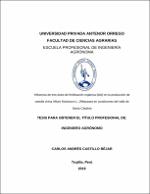Influencia de tres dosis de fertilización orgánica (biol) en la producción de cebolla china Allium fistulosum L. (Alliaceae) en condiciones del Valle de Santa Catalina

Ver/
Descargar
(application/pdf: 1.059Mb)
(application/pdf: 1.059Mb)
Fecha
2019Autor(es)
Castillo Béjar, Carlos Andrés
Metadatos
Mostrar el registro completo del ítemResumen
Esta investigación se realizó en las instalaciones del Campus UPAO II,
ubicado en la prolongación de la avenida Villareal S/N – Nuevo Barraza, distrito
de Laredo, provincia de Trujillo, región La Libertad, de febrero a marzo de
2018. El objetivo fue determinar la influencia de tres dosis de biol (400, 800
y 1200 L biol/ha) en el desarrollo, crecimiento y producción del cultivo de
cebolla china (Allium fistulosum L.). Se utilizó el diseño experimental de
bloques completamente al azar con cuatro tratamientos y cuatro repeticiones.
Se realizó un análisis de varianza, para determinar las diferencias
significativas; así mismo, se usó la prueba de significación de Duncan al 0.05
% de probabilidad, para evaluar el mejor tratamiento. La siembra se realizó a
un distanciamiento de 60 cm entre surcos y 15 cm entre plantas; el área
utilizada para el experimento fue de 240 m2. La fertilización con nitrógeno
(urea), se realizó a los quince días después de la siembra; en tanto que, la
aplicación de biol se realizó a los veinte días después de la siembra. La dosis
de biol fue de 400, 800 y 1200 L/ha; el testigo no tuvo dosis de biol. La mayor
altura de planta y el mayor número de hojas por planta, a los 35 días después
de la siembra se obtuvieron en el tratamiento T2 (800 L biol/ha), con 47.94 cm
y 9.13 unidades, respectivamente; el tratamiento T4, considerado testigo (0 L
biol/ha), obtuvo la menor altura con 36.70 cm y el menor número de hojas, con
8.25 unidades. El mayor diámetro de bulbo, la mayor longitud de hoja y el
mayor grosor de tallo se obtuvo con el tratamiento T3 (800 L biol/ha), con 1.75,
43.35 y 0.91 cm, respectivamente; el tratamiento T4 (testigo) ocupó el último
lugar con 1.13, 33.60 y 0.48 cm, respectivamente. En relación a la producción,
el tratamiento T2 (800 L biol/ha) produjo el mejor resultado con 44.8 t/ha; el
tratamiento testigo (T4), ocupó el último lugar con 31.4 t/ha. This researchwas carried out in the farm of UPAO II Campus, located on the
extension of Villarreal Avenue S/N - Nuevo Barraza, district of Laredo, province
of Trujillo, region La Libertad (Perú), from february to march 2018. The aim was
to determine the influence of three doses of biol (400, 800, and 1200 L biol/ha)
on the development, growth and production of the Chinese onion crop (Allium
fistulosum L.). The experimental design of blocks was completely randomized
with four treatments and four repetitions. An analysis of variance was
performed to determine the significant differences; likewise, the Duncan
significance test at 0.05% probability was used to evaluate the best treatment.
The sowing was carried out at a distance of 60 cm between rows and 15 cm
between plants; the area used for the experiment was 240 m2. Nitrogen
fertilization (urea) was carried out fifteen days after sowing; whereas, the
application of biol was carried out twenty days after sowing. The dose of biol
was 400, 800, and 1200 L/ha; the witness did not have a dose of biol. The
highest plant height and the highest number of leaves per plant, 35 days after
sowing were obtained withT2 treatment (800 L biol/ha), with 47.94 cm and 9.13
units, respectively; Treatment T4, considered a control (0 L biol/ha), produced
the lowest height with 36.70 cm and the lowest number of leaves, with 8.25
units. The largest bulb diameter, the longest leaf length and the largest stem
thickness were obtained with the T3 treatment (800 L biol/ha), with 1.75, 43.35,
and 0.91 cm, respectively; treatment T4 (control) was last with 1.13, 33.60, and
0.48 cm, respectively. According to production, the T2 treatment (800 L biol/ha)
produced the best result with 44.8 t/ha; the control treatment (T4), ranked last
with 31.4 t/ha.
Colecciones
- Ingeniería Agrónoma [99]

